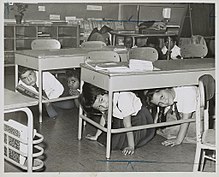
"Duck and cover" is a method of personal protection against the effects of a nuclear explosion. Ducking and covering is useful in offering a degree of protection to personnel located outside the radius of the nuclear fireball but still within sufficient range of the nuclear explosion that standing upright and uncovered is likely to cause serious injury or death. In the most literal interpretation, the focus of the maneuver is primarily on protective actions one can take during the first few crucial seconds-to-minutes after the event, while the film of the same name and a full encompassing of the advice also cater to providing protection up to weeks after the event.
The countermeasure is intended as an alternative to the more effective target/citywide emergency evacuation when these crisis relocation programs would not be possible due to travel and time constraints. Maneuvers similar, but not identical, to Duck and Cover are also taught as the response to other sudden destructive events, such as an earthquake or tornado, in the comparable situation where preventive emergency evacuation is similarly not an option, again, due to time constraints. In these analogously powerful events, Drop, Cover and Hold on likewise prevents injury or death if no other safety measures are taken.